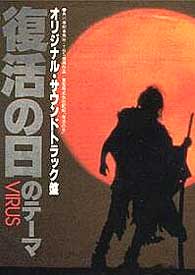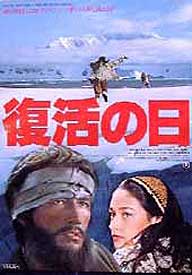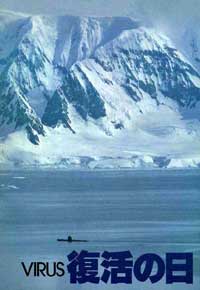 From a novel by Sakyo Komatsu, Virus aka Day of Resurrection aka The End (Fukkatsu no hi, Nikkatsu, 1980) has an international cast from Ken Ogata & Shinichi Chiba to Olivia Hussey & Chuck Conners. There's a theme-song by Janis Ian, & a disaster scenario effectively presented.
From a novel by Sakyo Komatsu, Virus aka Day of Resurrection aka The End (Fukkatsu no hi, Nikkatsu, 1980) has an international cast from Ken Ogata & Shinichi Chiba to Olivia Hussey & Chuck Conners. There's a theme-song by Janis Ian, & a disaster scenario effectively presented.
The most surprising aspect of the film is its international balance. The international edit has the events in Tokyo shortened, with the events involving the President of the United States (Glen Ford) getting more focus. Although the Japanese cast is a m;ite better than the American/Canadian cast, really everyone turns in a Disaster Movie performance of merit. This surprised me because so many films with international events rely on stereotypes & miscasting for characters representing every nation but their own. Director Kinji Fukasaku, best known for his violent yakuza epics, has put together a credible multilanguage film without cultural faux pas.
 Like the disaster movie genre generally the film is inconsequential, but it entertains & is livelier than most. Judged alongside some of the biggest soap operaish disaster epics like Airport (1970), Earthquake (1974) & Towering Inferno (1974), Virus holds its own. Like the disaster movie genre generally the film is inconsequential, but it entertains & is livelier than most. Judged alongside some of the biggest soap operaish disaster epics like Airport (1970), Earthquake (1974) & Towering Inferno (1974), Virus holds its own.
It was unfortunately a commercial bust in the international marketplace. This was probably because by 1980 the cycle of 1970s disaster movies was already passe, & had long become spoof fodder in such joky takes on disaster films as The Big Bus (1976) & eventually Airplane (1980). Plus the genre requires an "endangered all star cast" even if each actor gets only a couple minutes of screen time. With Virus names like George Kennedy & Robert Vaughn & Bo Svenson just couldn't fulfill the big-name expectation.
 An experimental virus escapes into the world & the virilulent "Italian flu" that results wipes out civilization in a matter of months.
An experimental virus escapes into the world & the virilulent "Italian flu" that results wipes out civilization in a matter of months.
The survivors are a submarine crew captained by Chuck Connors (they were at sea since before the plague began) & anyone who was in Antarctica (since the virus is dormant at low temperatures; we get no speculations about Himalayan or Arctic survivors).
There are a great many stations in Antarctica from numerous nations including Japan, Russia, Norway, the United States, & others. They form a confederacy to defend their small collective population from the virus reaching any of the stations, with Conners' nuclear submarine to enforce resistance to ships of dying men trying to reach Antarctica for medical attention.
There are many excellent vignettes of heroism, tragedy, & horror scattered through the film. There's also a lunatic warmongering general (Henry Silva) who blames Moscow for the end of the world though it was Americans who devised the biological weapon & Europeans who accidentally lost control of it. Before he dies the insane general activates an automated nuclear retaliation system that if not shut down will destroy what little is left of humanity.
I had frankly expected this to be a shitty movie but it was a heck of a lot better than disaster flicks usually are. It was the most expensively budgeted film Japan had made up to 1980. The American version is not as good as the full Japanese version, the Japanese cut having more scenes expressing misery & woe, more scenes set in Tokyo, & more of the Japanese Antarctic station. The Japanese cut has a more arresting conclusion. Though surprisingly enough the longer version has some dumb stuff like the insane 5-star general's role stretched out, while cool stars such as Ken Ogata are still too little seen.
copyright © by Paghat the Ratgirl
|

